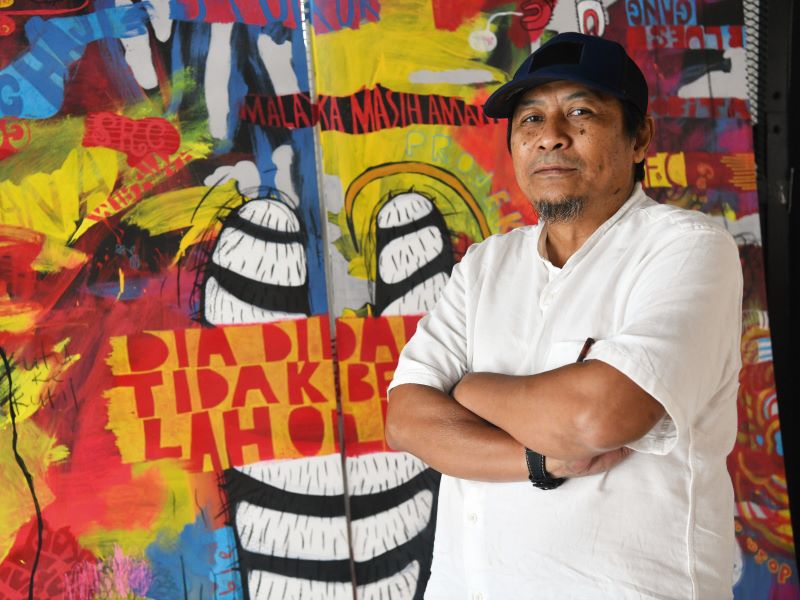
M Nasir, 67 come July 4, has written many hit songs over the years (Photo: Shahrin Yahya)
Before the music that made Singapore-born Datuk M Nasir a household name, there was art. He likens his urge to draw to a caveman carving figures on rocks and cave walls — because it was necessary. “For me, it’s a necessary thing to be an artist. In the first place, I’ve always loved art and always painted. I was in a trade school but not really into it. So after that, I went to Nanyang Academy of Fine Arts and studied Western painting. I started with realism but liked modern art, so I tried every genre.”
Leaning more towards music, which he also loves, was instinctive too. “Something clicked” after he wrote the lyrics for Alleycats’ Senandung Semalam (Yesterday’s Serenade) in 1979. “People liked it and it became a hit.
“It seemed like I had another kind of ability, writing songs, so I thought I’d concentrate on that for a while. But it became a long while,” M Nasir laughs.
Forty-five years to be exact. Over that time, he released his first solo album, Untuk Pencinta Seni, under Mohamed MN [his real name is Mohamad Nasir Mohamed]; became the frontman for folk-rock band Kembara, whose self-titled 1981 debut album was a hit too; and moved to Malaysia “to look for action lah”.
He has certainly got that, and more. On Aug 10, this industry “Sifu” will rock the Axiata Arena in Bukit Jalil, Kuala Lumpur, with Dato’ M.N45ir Cipta, a concert to celebrate his 4½ decades in the music scene.
By a happy turn of events, art will merge with music in a “curtain-raiser” for this grand affair — an exhibition featuring works inspired by M Nasir’s songs at Galeri Putih in Eco City Mall, KL, which opens on June 8.
“I’m a painter myself. Sitting there and talking to Nizam [Rahmat, the gallery founder and director], I thought, ‘Why not have a show of paintings inspired by songs, in conjunction with the concert?’ The theme he chose for it, “Sesat Di Kuala Lumpur”, brings back a lot of nostalgia for me. It’s the title of one of my earliest songs.”
Asked if that 1986 bestseller is relevant today, he laughs. “Sesat can be a lot of things. As an individual, I was sesat in the capital. KL represents life, the modern world, and I was lost in it.”
Burrowing into deeper meanings, he adds: “You feel lost because you are searching for something. Like most people, I was looking [to make] a living, for good art and a progressive society that can deal with progressive things.”
Such a society is likely to encourage its young to explore a career in the arts — hardly the case when M Nasir was starting out in the 1980s.
husin_othman_balada_osman_tikus.jpg
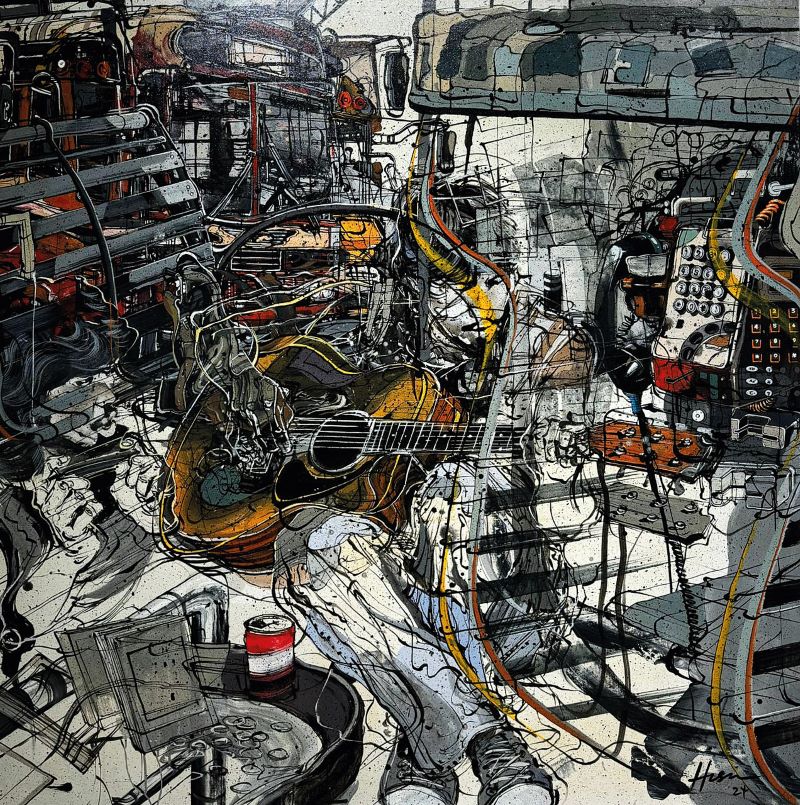
“Dulu, art was not seen as a good [career] choice. The Chinese saw it as something for ‘crazy’ people. It was worse for the Malays, who always thought of artists as weird,” he says.
If naysayers could see him now, they would probably hope their brood would consider the path he has taken. Last December, he was named Malaysia’s songwriter with the highest earnings by Music Authors’ Copyright Protection Bhd, during its Anugerah MACP 2023. His 1991 composition, Tiara, won in the category for Malay song with the most performances.
M Nasir, 67 come July 4, is modest about the top-earner status, putting it down to his having written many hit songs over the years. What he is more keen to talk about is the opportunity to observe life through music and art, inserting a “message” about contemporary goings-on in his songs, the writer as a messenger, and penning simple, catchy lyrics for “ordinary people” .
“Music is always viewed as entertainment but the art side of it is not fully appreciated — the processes involved, the subtexts and meanings. I enjoy music, listening to it, singing and composing. I want to go on forever. I still have the energy to perform and always try to give something to the audience.”
As such, retirement is not in his vocabulary. People speak about it, he says, including his wife, actress Marlia Musa.
“The industry has given me a unique sense of satisfaction. We create songs out of nothing; they take shape and people like them. It’s a joy other people cannot experience. As long as I can feel that joy, I will continue to create songs. I feel it will be hard for me to live if I were to retire.”
ronnie_mohamad_sesat_di_kuala_lumpur.jpg
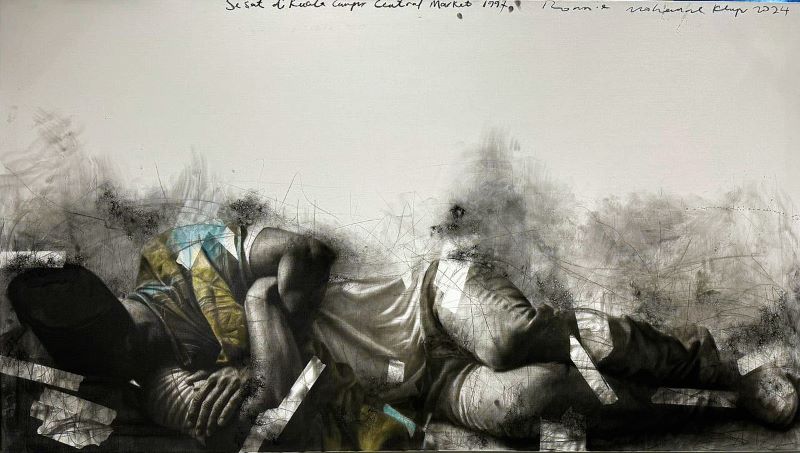
Artistes have approached him to pen songs for them. When he is working on one, he thinks of the singer and what he wants from him or her, and usually begins with the melody lines or rhythm.
But when composing for himself, “I just sing them out. I don’t know where the songs come from. It’s like when you are doing modern art. You don’t have the actual image until you finish the painting.”
Just like a self-portrait he did last year, which is on show at Sesat Di Kuala Lumpur. It was originally meant for a poster to promote a T-shirt. It depicts him brooding, almost angry, in a blend of yellow and black.
“There is so much meaning in the way artists interpret faces. But not many do portraits now. People want to see movement.”
Some of the artists involved in the current show are his friends and he is eager to see how they “draw out” his lyrics.
Last November, M Nasir contributed two paintings, Darwis Menari and Ekspresi, to Galeri Puteh’s Colours for Gaza exhibition, which raised funds for Palestinians caught in the war.
He is looking forward to the Aug 10 concert, where he will present more than 40 songs, including numbers composed for other singers. Among them are Padang Lalang (sung by Hattan), Rintik Hujan Di Kelopak Mawar (Dayangku Intan) and Kabut Serangkai Mawar (Zaiton Sameon).
Interpreting M Nasir’s music with paint and pen
20240604_peo_galery_puteh_datuk_m_nasir_msy_9.jpg

Three months after it opened in August 2022, Galeri Puteh launched Turun Tanah, an inaugural show that was significant because besides marking its start, the term, following Malay tradition, refers to a ceremony during which a baby touches the ground for the first time, symbolising its readiness to walk or run and face the world.
The gallery has been running, literally, since. As at April this year, it had hosted 18 shows comprising five solos and 13 group exhibitions, and taken part in a local art fair.
This month, there is Sesat Di Kuala Lumpur: Lagunya Begini, Tampaknya Begitu, featuring sculptures, prints, drawings and paintings by 60 artists inspired by the prolific output of singer, songwriter, musician, actor and producer Datuk M Nasir.
Participants, both senior and young, have lots of material to choose from, foremost of which are countless songs he had composed for himself and others — including the Alleycats, Sudirman Arshad, Sharifah Aini, Ella and Ramli Sarip — since 1979.
Sesat Di Kuala Lumpur, popular in the mid-1980s, was followed by Kembara Seniman Jalanan, the 1986 film directed by Nasir Jani. “It extends beyond simply getting lost in the capital and explores the challenges of living in a metropolitan city,” Galeri Puteh director Nizam Rahmat says of the song. “It delves into aspects of lifestyle, financial issues, politics and social humanitarian concerns, which can lead to crime and potentially destructive outcomes if not managed properly.”
Nizam, an album cover designer and music video creator, co-founded the 5,000 sq ft gallery in KL Eco City Mall, Bangsar, with his wife Mimie Abdullah, a former property agent who now manages the space’s operations and accounts. They used the old Malay spelling for puteh (white), symbolising purity and simplicity. There is also a personal significance: “It is our mother’s name, reflecting both cultural heritage and familial homage.”
As for why a commercial gallery, he explains: “It allows us to extend support beyond our own creative endeavours and provides a platform for a broader range of artists, especially with the ever-growing number of art graduates each year.” His previous roles as head of art management at Galeri Petronas and CEO of Segaris Art Centre have given him insights into the workings of art institutions and the market.
The idea for the exhibition came up in February this year when M Nasir visited the gallery to catch Estetika Timur, Awang Damit Ahmad’s solo, and they got talking.
“I’ve long desired to collaborate with someone like him, who is not only a composer, singer and actor, but also has an art education background. After seeing his studio in Sungai Buloh, Selangor, we thought, why not organise a show that encourages artists to think deeply and produce works that draw inspiration from songs written and performed by him, solo or with his group, Kembara,” Nizam adds.
Art on wings of song
Five artists on interpreting M Nasir's song
ADI YADONI
sentuhan_listrik.jpg
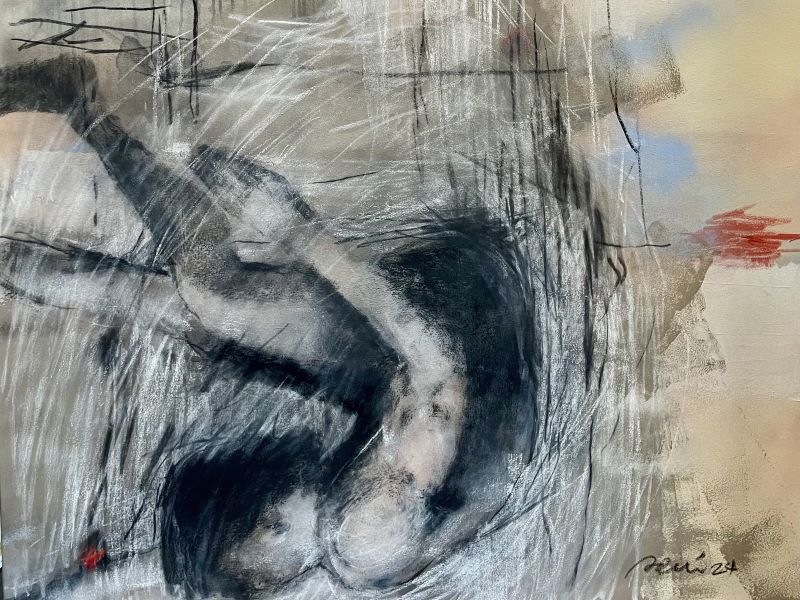
I first heard Sesat Di Kuala Lumpur when I was quite young, in Singapore. Apart from its santai (relaxed) folky sound, the song resonates with a deeper meaning of rediscovering and venturing into a new territory where you would meet and understand multiple cultures and lifestyles. It’s about acceptance and respect. Not specifically in KL, but anywhere in this vast world we live in.
When I was in art school, Kembara and M Nasir’s songs were on a loop, so they basically became a part of my working process, consciously or unconsciously.
This is the first time I’m creating an artwork that pays homage to a song by him. I chose Sentuhan Listrikmu because it is catchy and pop-ish. It’s the kind of song that, after a hard day, you just want to wind down and dance to. When I shared it with my wife, she liked it and it became her favourite too. For someone who isn’t an M Nasir fan,
I basically “electrocuted” her.
I live and work in Singapore and have been an artist and filmmaker for over 30 years. When I’m not painting or creating art, I produce or direct telemovies, commercials, short films and TV programmes.
KIDE BAHARUDIN
m_nasir_with_six-year-old_kide_baharudin.jpg
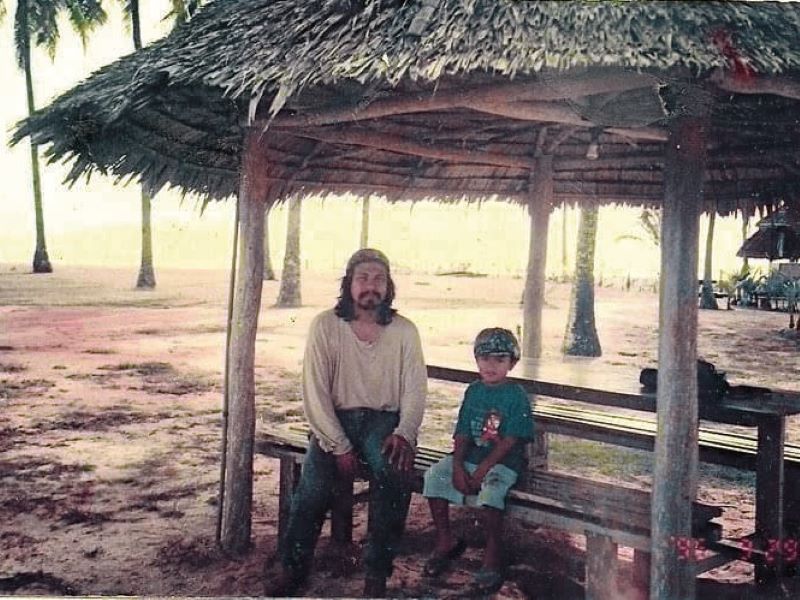
For Sesat Di Kuala Lumpur, I based my work on Bas No.13 by M Nasir and his band, and imagined lots of different stories. I did two paintings: Bas No.13 (Sosek Baghek 1) and
Bas No.13 (Sosek Baghek 2).
In Negeri Sembilan slang, sosek baghek means “to get lost”. The first artwork shows scenes of busy city life in KL: people walking to street stalls, riding a motorcycle, going to the pasar karat (flea market) and living in small apartments. There is construction going on, with skyscrapers in the background.
The second painting is about a bus getting lost in a small village. It’s about the cosy life there: a couple dating by the riverside, people fishing, chatting at a warung kopi and playing dam haji (checkers). I also portray how folks live in a kampung house, chilling in the living room and eating together, seated on the floor.
This show is really special for me because my wife Ika Sharom is also involved. She chose his Bonda for her painting of a mother and son inside a traditional kampung house that looks out to a paddy field.
In 1996, the musician and his family came to my family’s chalet, Penarik Inn, in Setiu, Terengganu. My mother took a photo of me, then six, with him. Now I’m 34 and I am getting a chance to do an art exhibition with M Nasir. Can’t imagine that.
MOHD AL-KHUZAIRIE ALI
To me, Sesat Di Kuala Lumpur captures the essence of navigating life in a big city. Surviving in KL requires discernment and self-care because the city offers both positive and negative influences. Ultimately, it’s up to us to make the right choices.
I drew inspiration from Anak-Anak Kita because its lyrics resonate with me, especially in the context of today’s younger generation. I see many young people becoming overly engrossed in gadgets, and neglecting traditional games and basic social interactions. Additionally, some have lost their sense of respect for elders.
I have been a full-time artist for 15 years. My work primarily focuses on ceramic sculptures, but I also incorporate mixed materials such as steel, wood and glass.
ISSAREZAL ISMAIL
issarezal.jpg

Galeri Puteh gave us the option to interpret any song by M Nasir for Sesat Di Kuala Lumpur. After giving it some thought and listening to a number of them, I decided on Impian Anak Jalanan, which helps me understand the value of ambition, hope and vision in our fight to survive. It makes me think back to when I was in my late teens in KL, an age when we have many hopes and dreams because we don’t know what the future holds.
During that period, I liked to walk and would willingly forgo taking the relatively cheap Bas Mini from Central Market back to my home in Jalan Ipoh. When walking, we can take our time, use our imagination and focus on the small details around us.
My piece, Cita dan Cipta I, reflects my story as an art school graduate with aspirations as high as the moon, depicted by an astronaut strolling through the city at night. Despite gravity, symbolic of pressures and burdens, he moves fearlessly through the ambiguous and dark space, giving his whole attention to the forward motion.
I have more than 20 years’ experience in art but only started producing it on a regular basis in the last eight years. I teach fine art at UiTM, Perak branch. My daily experiences, whether they relate to my relationships with society, the environment or myself, motivate me to create. Although I don’t adhere to any particular style, I frequently blend imagination and reality in my works.
ABDULLAH JONES
Requiem is inspired by M Nasir’s Balada Osman Tikus, from Kembara Seniman Jalanan. In the 1986 movie, the song’s titular character is a pickpocket (played by the latew poet Pyanhabib Rahman) who steals from Bujang (Nasir) a newcomer to the city.
Osman Tikus dies in the end. This work is to celebrate his death and that of morality in our country. Typical of my art, this acrylic piece has lots of writing on it. It serves as a social commentary on what is going on around me.
Among the words on the canvas are SPRM (Suruhanjaya Pencegahan Rasuah Malaysia, or the Malaysian Anti-Corruption Commission); Tabung Haji; Goldman Sachs; Anak MB (referencing the case of a chief minister’s son being charged with making false claims), and Menantu PM (another reference, this time to the MACC waiting to charge a former prime minister’s son-in-law with criminal breach of trust) and Brader, kita mesti terus hidup! (Brother, we must continue to live!), a refrain that hits home for those struggling to survive.
Requiem presents two contrasting situations: Osman Tikus steals because he is hungry, whereas some others steal because they want to get rich.
I started working on it two months ago, after being invited to take part in Sesat Di Kuala Lumpur. I write and do art full-time and have been at both for over 40 years.
'Sesat Di Kuala Lumpur' runs from June 8 to 30 at Galeri Puteh, KL Eco City. Sonik-Bingit!, known for producing waves of sounds in an experimental, ambient and energetic form, will perform at the opening, at 4pm, led by founder Irfan Mustafa. For details, visit galeriputeh.com.
This article first appeared on June 10, 2024 in The Edge Malaysia.

